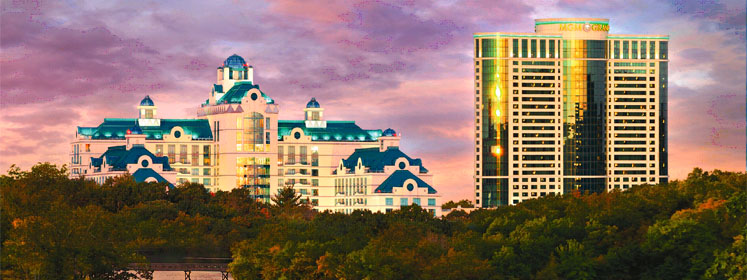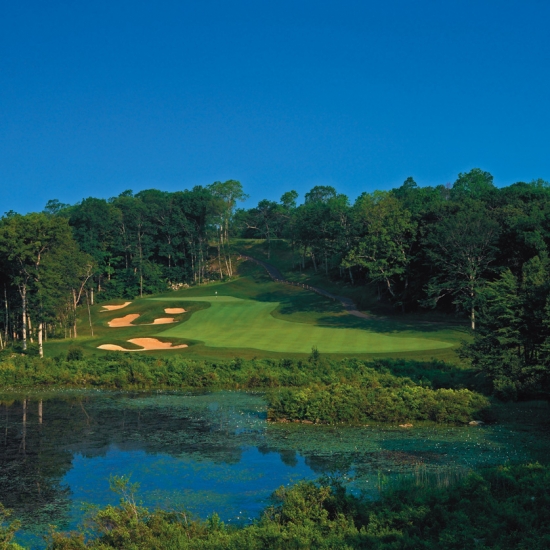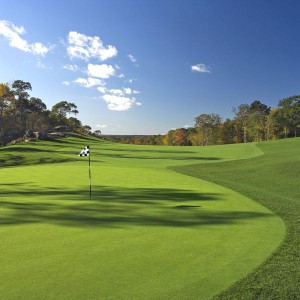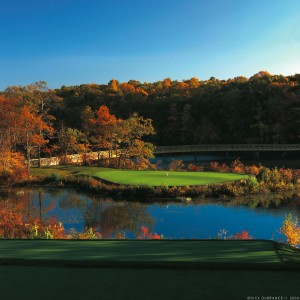
Though it’s in rural Connecticut, seemingly in the middle of nowhere, the truth must told–when approaching Foxwoods Resort by car it arises suddenly out of the countryside like the Emerald City in “The Wizard of Oz,” a suggestion that past television ads for the resort have played upon.
The Mashantucket Pequot Tribal Nation has indeed created a wonder in the North Stonington woods. Foxwoods began life in 1986 as a single high-stakes bingo hall, but the action grew into the largest resort casino complex in the world, with a towering hotel, theaters, nightclubs, a full house of high-end dining spots, a bushel of casual restaurants, and a jackpot of snack bars, not to mention the ever sweet siren song of the many gaming tables.
Even better, the Nation set Rees Jones loose on 900 acres across the street from the resort, and the May 2005 debut result was Lake of Isles–36 holes of splendid and challenging golf (though only the North Course is open to the public; the South Course is members only.) The complex is now enhanced by a Hank Haney Golf Academy, indoor and outdoor practice facilities, and a gracious 50,000 square foot clubhouse and grill (Matches Tavern), with an award-winning golf shop.

North Course, hole 17
The North Course is clearly a winner–copping the Golfweek Best in State award for four consecutive years. But it’s easy to toss strokes away here as breezily as dollar chips at the roulette table. The course demands attention, with a 135 slope rating–and that’s from the mid-tees (6,304 yards).
The tips extend beyond 7,300 yards, but mortals will not want to go there, unless to check out some of the dramatic and daunting views from the tee boxes, and there are many, as the course is big-shouldered, with lots of elevation and seven holes that skirt a picturesque 90-acre lake.
The secret at the North–or one of them–is getting safely away off the tee; fairways are ample, but straying from them hazardous, with a fair share of forced carries and dense Northeast woodlands to contend with–mighty pretty in the green of summer and glorious in the flaming colors of fall, but not too kind to hookers and slicers.

North Course, hole 3
The greens are huge, but well-protected throughout. And the par-3s, which include some of the prettiest elevated tee shots of the routing, can put a real spike in a scorecard.
As popular as the course has proven, the eighteenth hole had many a player fuming, with a forced carry over the lake to a slender landing area, beyond which was a gobbling bunker and then a sharp left dogleg besides, over another hazard.
The good news at the start of the 2010 season was that Jones had taken pity, and tinkered with the hole so that players falling short of perfection still had a prayer. The fairway was extended, the landing areas widened, and additional grassed areas planted on the landing side of the lake to shorten the carry. In an additional stroke of generosity, the fairway bunker was eliminated.

South Course, hole 11
The experience is similar on the South Course, though members and high rollers who manage a round there will certainly find fewer divots due to smaller number of rounds.
The conditioning is superb at LOI, and the service attentive, as one should rightly expect at a course with upscale rates in high season (off peak rates begin dropping in October). But there are great stay and play packages, and none of this is a concern anyway, if one’s luck is holding across the street.
This piece originally appeared in somewhat different form in the September/October 2010 issue of Troon Golf & Travel.
I stole a few lines in this piece from a post about an earlier visit to Lake of Isles. Click here for “By the Time We Got to Woodstock.”
The Mashantucket Pequot Tribal Nation has indeed created a wonder in the North Stonington woods. Foxwoods began life in 1986 as a single high-stakes bingo hall, but the action grew into the largest resort casino complex in the world, with a towering hotel, theaters, nightclubs, a full house of high-end dining spots, a bushel of casual restaurants, and a jackpot of snack bars, not to mention the ever sweet siren song of the many gaming tables.
Even better, the Nation set Rees Jones loose on 900 acres across the street from the resort, and the May 2005 debut result was Lake of Isles–36 holes of splendid and challenging golf (though only the North Course is open to the public; the South Course is members only.) The complex is now enhanced by a Hank Haney Golf Academy, indoor and outdoor practice facilities, and a gracious 50,000 square foot clubhouse and grill (Matches Tavern), with an award-winning golf shop.
The North Course is clearly a winner–copping the Golfweek Best in State award for four consecutive years. But it’s easy to toss strokes away here as breezily as dollar chips at the roulette table. The course demands attention, with a 135 slope rating–and that’s from the mid-tees (6,304 yards).
The tips extend beyond 7,300 yards, but mortals will not want to go there, unless to check out some of the dramatic and daunting views from the tee boxes, and there are many, as the course is big-shouldered, with lots of elevation and seven holes that skirt a picturesque 90-acre lake.
The secret at the North–or one of them–is getting safely away off the tee; fairways are ample, but straying from them hazardous, with a fair share of forced carries and dense Northeast woodlands to contend with–mighty pretty in the green of summer and glorious in the flaming colors of fall, but not too kind to hookers and slicers.
The greens are huge, but well-protected throughout. And the par-3s, which include some of the prettiest elevated tee shots of the routing, can put a real spike in a scorecard.
As popular as the course has proven, the eighteenth hole had many a player fuming, with a forced carry over the lake to a slender landing area, beyond which was a gobbling bunker and then a sharp left dogleg besides, over another hazard.
The good news at the start of the 2010 season was that Jones had taken pity, and tinkered with the hole so that players falling short of perfection still had a prayer. The fairway was extended, the landing areas widened, and additional grassed areas planted on the landing side of the lake to shorten the carry. In an additional stroke of generosity, the fairway bunker was eliminated.
Though it’s in rural Connecticut, seemingly in the middle of nowhere, the truth must told–when approaching Foxwoods Resort by car it arises suddenly out of the countryside like the Emerald City in “The Wizard of Oz,” a suggestion that past television ads for the resort have played upon.
The Mashantucket Pequot Tribal Nation has indeed created a wonder in the North Stonington woods. Foxwoods began life in 1986 as a single high-stakes bingo hall, but the action grew into the largest resort casino complex in the world, with a towering hotel, theaters, nightclubs, a full house of high-end dining spots, a bushel of casual restaurants, and a jackpot of snack bars, not to mention the ever sweet siren song of the many gaming tables.
Even better, the Nation set Rees Jones loose on 900 acres across the street from the resort, and the May 2005 debut result was Lake of Isles–36 holes of splendid and challenging golf (though only the North Course is open to the public; the South Course is members only.) The complex is now enhanced by a Hank Haney Golf Academy, indoor and outdoor practice facilities, and a gracious 50,000 square foot clubhouse and grill (Matches Tavern), with an award-winning golf shop.
The North Course is clearly a winner–copping the Golfweek Best in State award for four consecutive years. But it’s easy to toss strokes away here as breezily as dollar chips at the roulette table. The course demands attention, with a 135 slope rating–and that’s from the mid-tees (6,304 yards).
The tips extend beyond 7,300 yards, but mortals will not want to go there, unless to check out some of the dramatic and daunting views from the tee boxes, and there are many, as the course is big-shouldered, with lots of elevation and seven holes that skirt a picturesque 90-acre lake.
The secret at the North–or one of them–is getting safely away off the tee; fairways are ample, but straying from them hazardous, with a fair share of forced carries and dense Northeast woodlands to contend with–mighty pretty in the green of summer and glorious in the flaming colors of fall, but not too kind to hookers and slicers.
The greens are huge, but well-protected throughout. And the par-3s, which include some of the prettiest elevated tee shots of the routing, can put a real spike in a scorecard.
As popular as the course has proven, the eighteenth hole had many a player fuming, with a forced carry over the lake to a slender landing area, beyond which was a gobbling bunker and then a sharp left dogleg besides, over another hazard.
The good news at the start of the 2010 season was that Jones had taken pity, and tinkered with the hole so that players falling short of perfection still had a prayer. The fairway was extended, the landing areas widened, and additional grassed areas planted on the landing side of the lake to shorten the carry. In an additional stroke of generosity, the fairway bunker was eliminated.
The experience is similar on the South Course, though members and high rollers who manage a round there will certainly find fewer divots due to smaller number of rounds.
The conditioning is superb at LOI, and the service attentive, as one should rightly expect at a course with upscale rates in high season (off peak rates begin dropping in October). But there are great stay and play packages, and none of this is a concern anyway, if one’s luck is holding across the street.
This piece originally appeared in somewhat different form in the September/October 2010 issue of Troon Golf & Travel. The current issue can be viewed here: http://www.troongolf-digital.com
The experience is similar on the South Course, though members and high rollers who manage a round there will certainly find fewer divots due to smaller number of rounds.
The conditioning is superb at LOI, and the service attentive, as one should rightly expect at a course with upscale rates in high season (off peak rates begin dropping in October). But there are great stay and play packages, and none of this is a concern anyway, if one’s luck is holding across the street.
This piece originally appeared in somewhat different form in the September/October 2010 issue of Troon Golf & Travel. The current issue can be viewed here: http://www.troongolf-digital.com




